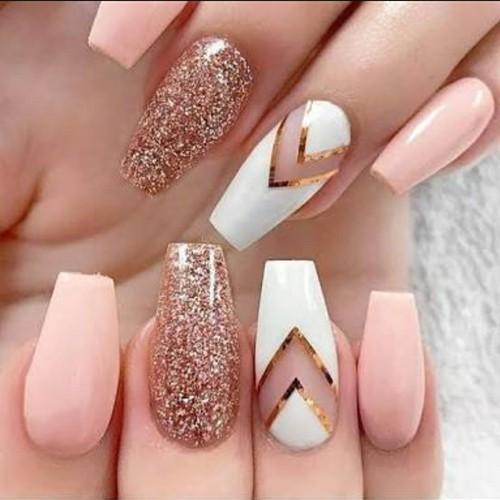When we desired long nails back in the day, acrylics seemed our only option. However, nowadays, we have countless options: simple treatments, such as press-on nails, to more recent developments such as gel extensions.
Gel extensions aren’t a novel method in and of itself, but despite the prevalence of gel polish, it’s still pretty much unknown. This manicure technique may solve our beauty-inspired prayers, but it has some negligible drawbacks.
It may last up to four weeks, like artificial nails (one of the earliest salon-approved techniques to lengthen your natural manicure), but both have a reputation for being destructive. That is why, before going into the realm of gel extensions, it is critical to determine what they are. So, what exactly are gel extensions, and how do they differ from gels and acrylics? This article explains everything to you.
Image Source- Sharon McCutcheon on Unsplash
- What Exactly Are Gel Extensions?
Acrylic nails and Gel extensions aren’t the same, but they’re close. Acrylic is a two-step procedure comprising a liquid and a powder drying by air. Whereas gel extensions are applied using hard or structural gel and cured with a UV or LED light. Both methods have a similar appearance and feel.
Hard gel, the more durable of the two, is also the most commonly utilized form of gel for extensions, although it requires more effort to remove. That said, structure gel can be easily removed and is ideal for people who wish to enhance the durability of their nails without the hardness and weight of hard gel.
It forms a strong capping on the natural nail but isn’t as durable as a hard gel. Hard gel, on the other hand, is the most durable type of gel polish available and produces a sturdier, more durable exterior.
Image Source- https://unsplash.com/photos/3J5K-Jb6GRM
- Procedure For Applying for Gel Extensions
Natural nail prep for gel extensions begins with cleansing, cuticle clipping, and filing. To ensure that the nails are clear of grease, wipe them with alcohol. Otherwise, the gel will not adhere. To ensure adhesion and avoid lifting, you may apply a primer or dehydrator. After preparing the nails, select a shape to suit each nail and adequately secure the form to the nail. That’s where the builder gel nails comes in, beginning with a thin covering and expanding the gel to the necessary length onto the form.
Typically, the application should begin in the center of the nail, just below where the form joins the natural nail, and work your way up to the desired length. You don’t have to get to the cuticle when applying the initial application of builder gel. Instead, you should go a little further down the nail with each successive layer.
After each layer, cure the nail for a minute with a light. Two or three coatings may be sufficient, but depending on the length and form needed, you might require seven or more coats of builder gel. The rest of your procedure will be similar to a conventional gel manicure: your color will be applied with standard soft gel polish and cured layer by layer. If you get nail art, the artist will adorn your tips before sealing your nails with a gel top coat.
Gel extension application isn’t a procedure that should be rushed, so set aside 1-2 hours depending on the length and form of the nail you want. If you wish to nail art, it takes a bit more time simultaneously.
Image Source-Giorgio Trovato on Unsplash
- How To Remove Gel Extensions?
Gel extensions should last between 2-4 weeks or more if maintained appropriately. However, the removal process is critical to preserving the health and strength of your natural nail. You should never attempt to remove your gel extensions at home since gel polish is utilized; you cannot soak off your extensions like a typical UV-light manicure. Hard gel is incredibly resistant and will not be removed with foils or acetone. To remove them, you must break through the top seal, necessitating a professional nail drill.
Almost 90% of the gel must be drilled away, and the remaining substance is removed by wetting your nails with acetone and brushing it off with a nail file. However, it’s recommended to give your nails ample time to grow out before having your extensions entirely removed. You don’t want to take off your gels too quickly.
It’s a weakening process, so let them grow out or have a fill. The procedure of filling in is identical to that of acrylics. Your manicurist should buff and drill down where growth emerges on the nail to create a smooth surface. The freshly-buffed tip is then cured with additional gel.
Image Source-https://www.pexels.com/photo/selective-focus-photography-of-woman-manicuring-person-3422099/
- Price Of Gel Extensions
The cost of your gel nail extensions might vary depending on several factors. These include the location (gel extensions tend to cost more in major cities like New York City and Los Angeles), design (the more elaborate the designs, the more you’ll spend), and the nail tech’s expertise. Gel nail extensions, for example, might cost as low as $30 in your local manicure store, but at a nail tech with A-list customers, the price can rack up to $80 or more.
Conclusion
Gel extensions can be a safe option when applied and removed correctly. They’re said to be a healthier and longer-lasting alternative to acrylics because they don’t include powder or harsh chemicals like toluene and methyl methacrylate. You just need to choose an expert you can trust to get your beautiful nails done.








